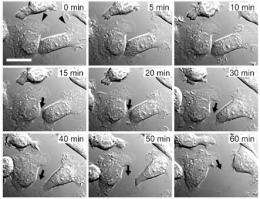September 21, 2010 report
Animal cells communicate electrically over long distances via nanotubes

(PhysOrg.com) -- A new study has discovered that animal cells communicate electrically with each other via tunneling nanotubes (TNTs). The membrane tubes contain a protein called F-actin and connect cells over long distances to enable the exchange of molecules and organelles between the cells.
Researchers based at the Department of Biomedicine of the University of Bergen in Norway demonstrated a two-way exchange of electrical signals between cells connected by nanotubes 10 to 70 μm long in a normal rat kidney. They also demonstrated electrical coupling in other types of cells, which suggests electrical coupling via TNTs may be a much more common phenomenon in animal cells than previously thought.
The study found the strength of electrical coupling depended on the length and number of TNT connections, and the coupling was voltage-sensitive. Electrical coupling was inhibited by the presence of a known gap-junction blocker, meclofenamic acid, and was not present in cell types that lacked gap junctions. Gap junctions are proteins that form a porous junction between adjacent cells, and the study clearly demonstrated that a current flows down the nanotube and causes ion channels to open in the connecting cell’s membrane, as long as a gap junction is present.
The ions entering the cell can have a variety of effects, such as modulating cell movements, and this may help to explain phenomena like the coordinated cell migrations seen in developing embryos as cells congregate to form structures such as the neural tube.
Co-author of the paper, published in the Proceedings of the National Academy of Sciences (PNAS), Hans-Hermann Gerdes, said the discovery was akin to ultra-thin telephone cables between cells, allowing them to talk to one another.
Gerdes and his colleagues first discovered protein nanotubes (also called membrane nanotubes) in the kidney six years ago using light microscopy. Apart from forming a means of electrical coupling, the nanotubes have also been shown to be able to transport molecules, viruses and prions from cell to cell, at least in a Petri dish. It is not yet known how cells produce nanotubes or how they open the membrane of another cell several cell-widths away.
Some scientists doubted the initial discovery of nanotubes, since there seemed to be no strong evidence that nanotubes are needed physiologically. One critic was Yale microbiologist Walther Mothes, who said he was impressed by the new finding that nanotubes use gap junctions for electrical communication, which he said makes a lot of sense, and should lead to further study of TNTs.
More information: Xiang Wang, et al. Animal cells connected by nanotubes can be electrically coupled through interposed gap-junction channels, Proceedings of the National Academy of Sciences, Published online before print September 20, 2010, doi:10.1073/pnas.1006785107
© 2010 PhysOrg.com
















